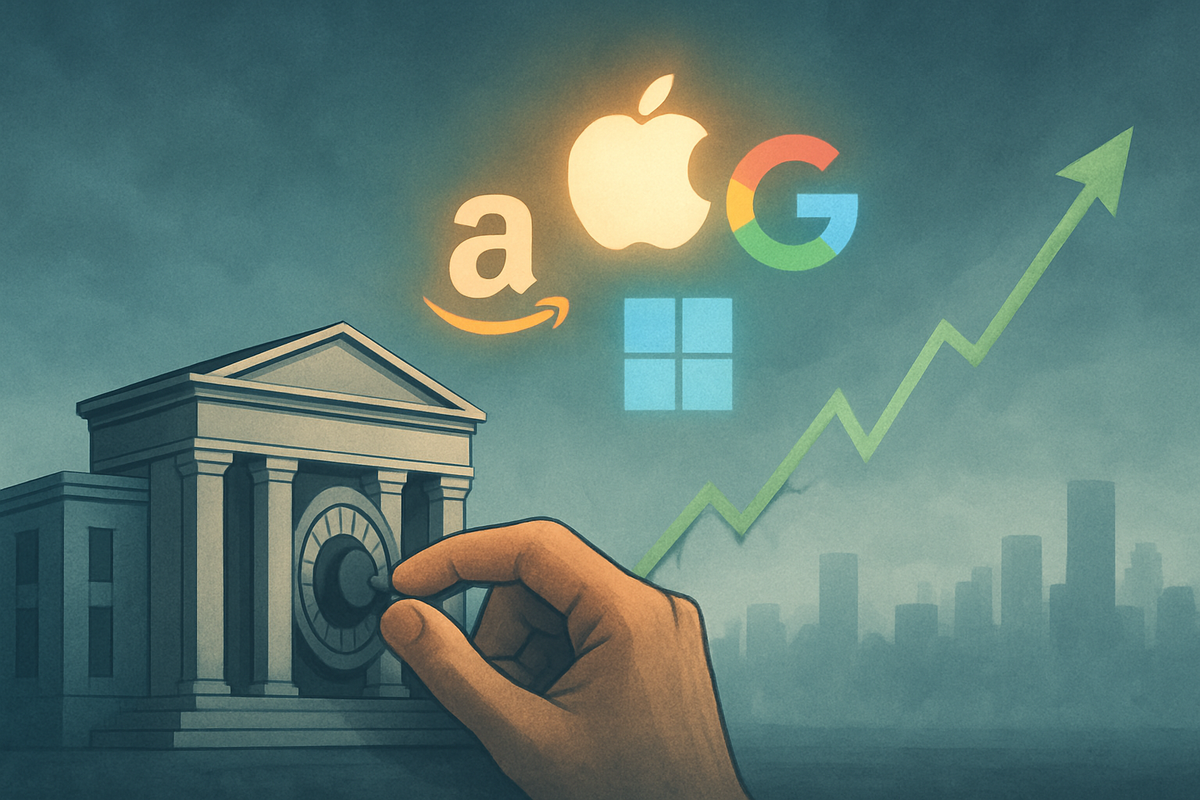Financial News
Fed's Cautious Stance and Big Tech's Earnings: A MarketWatch Deep Dive into October 2025's Financial Crossroads

As October 2025 draws to a close, the financial markets find themselves at a critical juncture, navigating the dual currents of a Federal Reserve committed to a cautious monetary policy and the powerful, yet complex, ripple effects of Big Tech's latest earnings reports. MarketWatch analysis indicates a palpable sense of uncertainty, with the Fed's recent 25-basis-point rate cut on October 29th, 2025, being met with Chair Jerome Powell's immediate caveat that further cuts are "not a foregone conclusion." This measured approach, coupled with a U.S. government shutdown hindering crucial economic data releases, has created a "drive in the fog" scenario for policymakers and investors alike.
Simultaneously, the much-anticipated third-quarter earnings from the "Magnificent Seven" tech giants—Apple (NASDAQ: AAPL), Amazon (NASDAQ: AMZN), Alphabet (NASDAQ: GOOGL), Microsoft (NASDAQ: MSFT), Meta (NASDAQ: META), Nvidia (NASDAQ: NVDA), and Tesla (NASDAQ: TSLA)—have largely met expectations, fueled by robust demand in artificial intelligence (AI) and cloud computing. However, their immense market capitalization and the broader market's reliance on their performance have ignited debates about potential overvaluation and the risk of a sudden correction, casting a shadow over an otherwise optimistic tech narrative. The market's immediate reaction to Powell's cautionary tone saw the S&P 500 (INDEXSP: .INX) relinquish gains, underscoring the sensitivity to monetary policy guidance amid a tech-driven, yet potentially overheated, market.
The Fed's Tightrope Walk Amidst Data Blackout
The Federal Reserve's decision on Wednesday, October 29, 2025, to implement a 25-basis-point interest rate cut, bringing the federal funds rate to a target range of 3.75%-4.0%, was largely anticipated and priced into the market. However, the subsequent remarks from Fed Chair Jerome Powell proved to be the more significant market mover. Powell's assertion that a further rate reduction in December is "not a foregone conclusion" injected a strong dose of caution into investor sentiment, causing the S&P 500 to pull back from earlier gains and the 2-year Treasury yield to tick higher as expectations for future easing were recalibrated.
This cautious stance is heavily influenced by a confluence of factors, most notably the ongoing U.S. government shutdown. This shutdown has severely impacted the availability of critical economic data, leaving the Fed to make policy decisions with incomplete information. Powell explicitly cited "uncertainty about the economic outlook" and "downside risks to employment" as key reasons for the Fed's reluctance to commit to a more aggressive easing path. Market analysts, including those at MarketWatch, suggest that the Fed's easing might be a reactive measure to a slowing economy rather than solely a response to diminishing inflation, with concerns growing about stalled labor markets and rising consumer delinquency rates across various loan categories.
The timeline leading up to this moment has been characterized by persistent inflation concerns earlier in the year, followed by signs of economic deceleration that prompted the Fed to consider rate cuts. However, the unexpected government shutdown in late October has thrown a wrench into the data-dependent approach the Fed prefers. Key players involved are, of course, the Federal Reserve Open Market Committee (FOMC) members, with Chair Powell at the helm, whose pronouncements are meticulously scrutinized by investors, economists, and public companies. The initial market reaction on October 29th underscored the market's sensitivity to forward guidance, highlighting a revised expectation for fewer, more deliberate rate cuts in the near term.
Big Tech's Enduring Influence and Market Concentration
The third-quarter earnings season, particularly for the "Magnificent Seven" tech behemoths, has once again underscored their unparalleled influence on the broader stock market. These companies—Apple (NASDAQ: AAPL), Amazon (NASDAQ: AMZN), Alphabet (NASDAQ: GOOGL), Microsoft (NASDAQ: MSFT), Meta (NASDAQ: META), Nvidia (NASDAQ: NVDA), and Tesla (NASDAQ: TSLA)—collectively represent a staggering 37.4% of the S&P 500's (INDEXSP: .INX) weighting and have been the primary architects of market gains throughout 2025. Their performance is seen as not just a bellwether, but a fundamental driver of the overall market's direction.
Analysts widely anticipated strong earnings from these tech giants, largely propelled by accelerating revenues in artificial intelligence (AI), cloud computing, and digital advertising. The transition of AI-powered services from experimental stages to full enterprise integration has been a significant growth catalyst. Nvidia (NASDAQ: NVDA), a cornerstone of AI infrastructure, notably reached a $5 trillion market capitalization on October 29th, 2025, a testament to the insatiable demand for its specialized hardware.
However, the immediate impact of earnings releases on October 30, 2025, presented a mixed picture. While companies like Alphabet (NASDAQ: GOOGL) saw gains, Microsoft (NASDAQ: MSFT) and Meta (NASDAQ: META) experienced slight dips in after-hours trading, possibly due to specific outlooks or charges. MarketWatch has voiced concerns about the unprecedented overvaluation of the U.S. stock market, particularly the concentration of wealth and power within these few dominant tech firms. This concentration, while driving market highs, is seen as potentially stifling broader innovation and increasing the risk of a "sudden correction," a sentiment echoed by institutions like the Bank of England. The debate continues among experts: is the current AI boom a sustainable revolution, or a speculative bubble on the verge of bursting?
Wider Significance: A New Era of Market Dynamics
This intricate interplay between a cautious Federal Reserve and the dominant influence of Big Tech earnings signals a significant shift in broader industry trends. The market's reliance on the "Magnificent Seven" for growth highlights a growing concentration of economic power, a trend that has accelerated in recent years. This phenomenon raises questions about market health and diversity, as a substantial portion of overall market performance is tied to the fortunes of a select few. The robust demand for AI, cloud computing, and digital advertising, while beneficial for these tech giants, also underscores the increasing digitalization of the global economy, creating both opportunities and challenges for competitors and partners.
The potential ripple effects are extensive. Smaller tech companies, while potentially benefiting from the overall AI boom, may struggle to compete with the vast resources and market share of the giants. Traditional industries might find themselves increasingly dependent on the technological infrastructure provided by these titans. Regulatory bodies worldwide are closely monitoring the market power of these firms, with ongoing discussions about antitrust measures, data privacy, and the societal implications of AI development. The Bank of England's warning about overvaluation suggests that policymakers are acutely aware of the systemic risks posed by such market concentration.
Historically, periods of significant technological advancement have often been accompanied by concentrated market leadership, but the current scale and speed of this concentration are arguably unprecedented. Comparisons to the dot-com bubble of the late 1990s are inevitable, though many argue that today's tech giants possess more robust business models and profitability. However, the sheer valuation multiples and the rapid ascent of AI-driven stocks invite scrutiny. The current government shutdown further complicates the regulatory landscape, as the lack of comprehensive economic data makes it harder for regulators to assess market stability and potential risks accurately.
What Comes Next: Navigating Uncertainty and Opportunity
Looking ahead, the short-term market outlook is likely to remain characterized by volatility and sensitivity to both Federal Reserve communications and ongoing Big Tech performance. Investors will be closely watching for any shifts in the Fed's forward guidance, particularly regarding the prospect of a December rate cut. The resolution of the U.S. government shutdown will be crucial, as the resumption of official economic data releases will provide much-needed clarity for both policymakers and market participants. Without this data, the Fed's "driving in the fog" approach will persist, potentially leading to more cautious and unpredictable policy decisions.
In the long term, the trajectory of Big Tech and the broader market will heavily depend on the sustained profitability and innovation within the AI, cloud, and digital advertising sectors. Companies outside the "Magnificent Seven" will need to identify strategic niches and adapt rapidly to leverage these technological shifts, or risk being marginalized. Potential strategic pivots for many firms might include increased investment in AI integration, enhanced cybersecurity measures, and a focus on sustainable growth models rather than purely speculative ventures.
Market opportunities may emerge in sectors that can effectively integrate AI to improve efficiency and create new products, as well as in companies providing essential infrastructure for the AI boom. Conversely, challenges will include navigating potential regulatory headwinds, managing high valuations, and responding to shifts in consumer behavior. Potential scenarios range from a continued, albeit slower, tech-led market expansion, to a significant market correction if overvaluation concerns materialize or if the broader economy falters more severely than anticipated. Investors should prepare for a landscape where agility and a deep understanding of technological and macroeconomic trends are paramount.
Wrap-Up: A Market at a Crossroads
In summary, the financial markets as of late October 2025 are navigating a complex and potentially precarious environment. The Federal Reserve's cautious stance on rate cuts, largely influenced by economic uncertainty exacerbated by a government shutdown, signals a period of measured monetary policy. This contrasts with the powerful, yet concentrated, influence of Big Tech earnings, which continue to drive significant market gains, particularly in AI-related sectors. The key takeaway is a market torn between the fundamental strength and innovation of leading technology companies and growing concerns about overvaluation and the systemic risks associated with such concentrated wealth.
Moving forward, the market will likely remain highly reactive to any signals from the Fed regarding future rate decisions, with every word from Chair Powell meticulously dissected. The resolution of the government shutdown is paramount, as the return of reliable economic data is essential for informed decision-making across all sectors. Investors should also pay close attention to the ongoing debate surrounding Big Tech valuations; while their earnings remain robust, the potential for a correction, as highlighted by MarketWatch and other institutions, cannot be ignored.
What investors should watch for in the coming months includes the evolution of the Fed's monetary policy, the resolution and aftermath of the government shutdown, further developments in AI innovation and adoption, and any shifts in regulatory scrutiny towards dominant tech firms. The current period represents a significant crossroads, where the interplay of macroeconomic policy and technological advancement will dictate the market's trajectory and lasting impact for years to come.
This content is intended for informational purposes only and is not financial advice
More News
View More




Recent Quotes
View More
Quotes delayed at least 20 minutes.
By accessing this page, you agree to the Privacy Policy and Terms Of Service.



